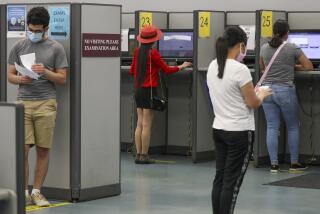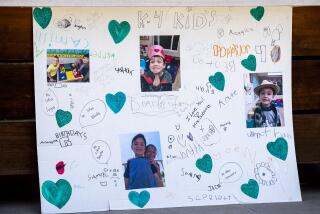Pro Teaches Teens Survival Skills Behind the Wheel
SYRACUSE, N.Y. — Three years licensed but with little actual driving experience, 19-year-old Scott Owens is itching to slide behind the wheel of the 2005 Chevrolet Impala, the test car for this session of a unique driving program.
As he waits his turn, he’s just like any other teenage boy promised the keys to Dad’s car -- fidgety, with a broad smile across his face.
A few minutes later, in an empty parking lot with a course marked by traffic cones, Owens is put through the paces by instructor Bob Featherly, whose jovial demeanor belies the seriousness of the exercise.
“Why do you keep driving over the cones? I don’t want you to hit any people,” Featherly said.
“Am I [going] straight? I haven’t driven in three years. My parents won’t let me,” Owens said.
“I can see why. I don’t think you’re going to make it as a race car driver.”
“I’m good at braking,” Owens said.
“We’ll go around again,” Featherly said. “There are still some cones standing.”
Owens was among more than 80 young drivers and nearly as many parents participating in Driver’s Edge, a free program designed by former racer Jeff Payne, who has been touring the country the last three years to teach Generation Y some driving skills and show them how to avoid becoming a statistic.
The statistics are compelling: Motor vehicle crashes, not drugs or guns, are the leading cause of death for people 15 to 20 years old, causing about one-third of all fatalities.
“We’re sick and tired of seeing all these little white crosses around,” Payne said. “Most drivers, regardless of their age, if they’re ever faced with a panic situation, they just don’t know how to properly act. And most don’t know their own capabilities or their vehicle’s capabilities. Ninety percent of driving is done at 50% of a vehicle’s capabilities.”
Payne’s audience sat crammed inside a leaking tent at the New York State Fairgrounds to listen to his message, which he plans to bring to 20 cities by the end of the year. It hits close to home -- eight teens have died in non-alcohol-related crashes during the last two years in the nearby LaFayette school district.
“I’ve been at LaFayette six years and lost eight kids, and all were phenomenal kids with very bright futures,” said LaFayette Junior-Senior High Principal Paula Cowling.
It’s one reason Payne has made the long trip from his home in Las Vegas, where his not-for-profit organization is based.
“Over 1,300 16- to 20-year-olds are killed or injured every single day in car collisions,” he said. “You’re not necessarily special. It happens everywhere. It can happen to you.”
The two-day clinic begins with a video, “In the Blink of an Eye,” that recounts a horrific lunchtime accident in Las Vegas almost two years ago. Five girls were pinned in a car that wrapped around a pole after the teenager at the wheel swerved to avoid something and lost control. She was driving below the speed limit.
When the video ends, many in the audience are blinking back tears.
“Because she panicked and overreacted, two girls were killed, one girl lost a leg, and just last month, the father of the girl who was driving and was killed instantly killed himself because he couldn’t live without his daughter anymore,” Payne said. “You don’t have to be going that fast.”
Over the next five hours, the students take a class about the mechanics of a car -- the importance of checking fluids and pressure and getting familiar with what’s under the hood. In another session, a state police simulator shows what happens inside a vehicle during a rollover. Students try on distortion goggles to experience the effects of alcohol on the senses.
What makes the program unique, is the hands-on experience it offers students through its fleet of Chevys and BMW 325i sedans. In a parking lot usually hosed down by a firetruck -- the place where Owens’ skills and Featherly’s patience are tested on the braking course -- students learn about panic braking and changing lanes abruptly to avoid an obstacle. They learn how to react during a skid.
“There’s a big difference from what students are doing here versus the parallel parking exercises that they do in traditional driver’s education,” said Steven Tepper, chief operating officer of Driver’s Edge. “We’re not spending enough time teaching our kids how to drive.”
The teens eagerly take advantage of the opportunity, screeching and smoking the tires as they skid through marked courses. Most quickly improve -- even Owens, who hit nearly every traffic cone on his first two tries around the braking course.
“What people need to do is to have an experience where they’re not panicking just once and know that they don’t have to panic,” Tepper said.
The program has 30 to 35 instructors who are professional race car drivers. It accepts young people between the ages of 15 and 21 who carry a valid permit or license. Those younger than 18 need their parents’ consent.
When compared to any other age group, drivers 16 to 20 have the highest death and injury rates in crashes per 100,000 licensed drivers, according to the U.S. Department of Transportation and the Insurance Institute for Highway Safety.
Judging by those statistics, it’s easy to understand why teenagers are roundly criticized for being reckless and irresponsible behind the wheel.
Payne, for one, doesn’t subscribe to that belief.
“The way our system was set up in this country, none of us are ever taught how to drive to begin with,” Payne said. “We’re simply just taught to pass a test.”
Past research indicates Payne is fighting an uphill battle.
“From the beginning of time, the key has been driver behavior,” said Susan Ferguson, senior vice president for research at the Insurance Institute for Highway Safety. “You can have all the skills in the world, but it is how you choose to drive that is going to make a difference.”
Driver’s Edge, whose chief sponsor is Bridgestone Corp., has been offered to more than 10,000 young drivers and parents in Los Angeles, Phoenix, Minneapolis, Reno Detroit, Nashville, Chicago and the Washington area. The program has scheduled stops in Denver, Seattle, Dallas/Fort Worth and Las Vegas.
Payne’s goal is to expand the program to every state, maybe even lure some NASCAR stars as guest instructors.
Peggy Vaughan, of the Syracuse suburb of Liverpool, registered her 17-year-old daughter, Cristine, in the program a month after a schoolmate was killed in a drunk-driving accident.
“You realize that the kids don’t know much,” she said. “I never learned it. If somebody can show them how to avoid a serious accident, everybody should learn it.”
More to Read
Sign up for Essential California
The most important California stories and recommendations in your inbox every morning.
You may occasionally receive promotional content from the Los Angeles Times.










